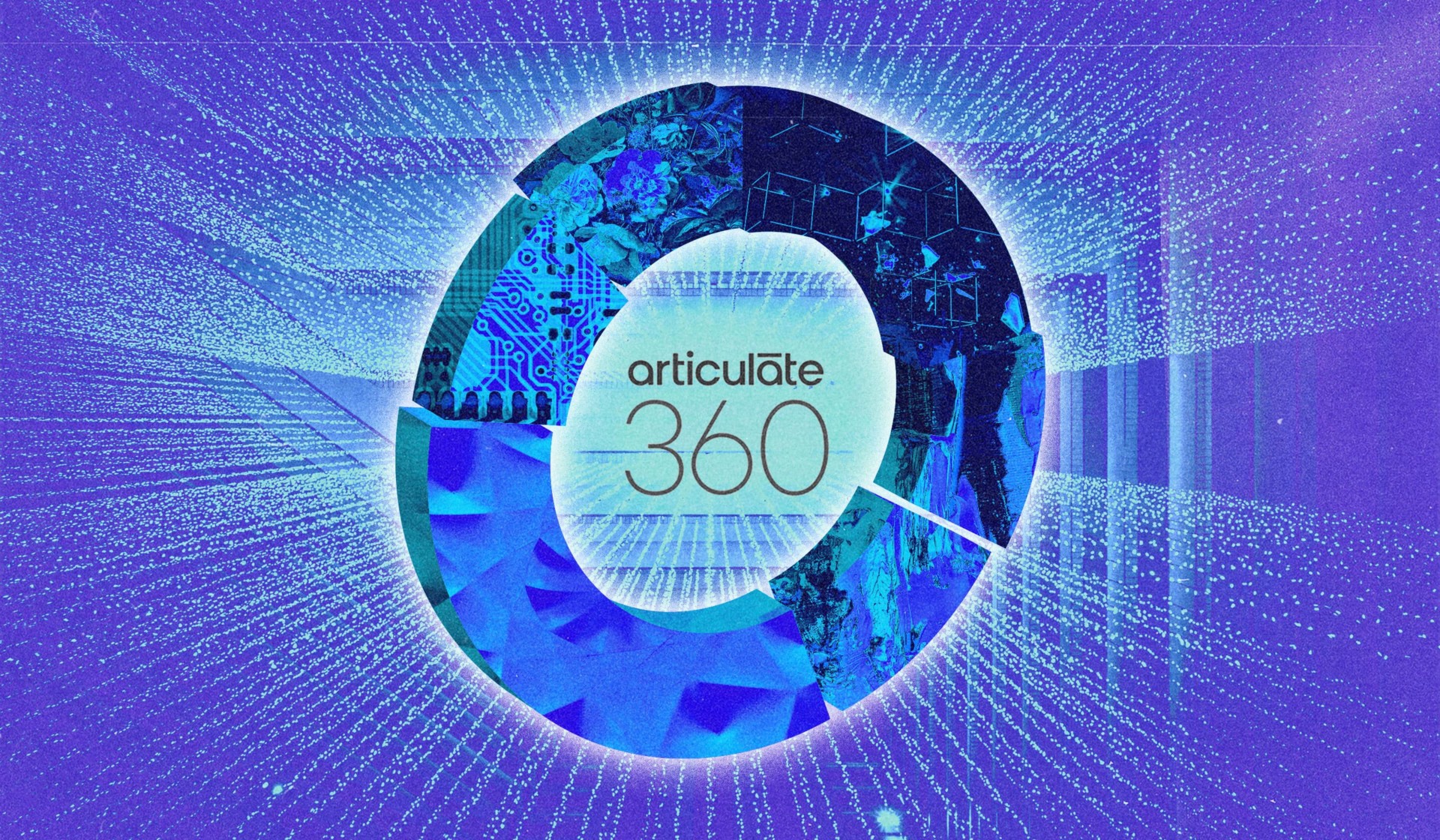It’s no secret that we love using Articulate 360’s suite of programs for eLearning. Compared to other eLearning development tools, we think Articulate outperforms the rest and helps us deliver consistent, beautiful, high-quality work to our clients. What makes Articulate 360 authoring tools our go-to for course development, and how does it compare to other leading programs like Adobe Captivate and Elucidat?
Comparing Articulate products to other eLearning development tools
Articulate Storyline vs. Adobe Captivate
Adobe has long held its place in the software world for its industry-standard creative suite. And its authoring tool, Adobe Captivate, is an adequate option for creating more traditional VO-led (voiceover-led) eLearning content. We’re bigger fans of Articulate Storyline for the same purpose. Here’s why…
One advantage most folks see in Adobe Captivate is that it allows users to easily create responsive content. But, a lot of tools do that now. There are eLearning development tools made to be mobile-first applications right “out of the box”, like Articulate Rise or Elucidat (we’ll get into those two more in a minute)—just because Captivate can get the job done, doesn’t mean it’s the best tool for the job in the first place. It’s like using a rubber mallet to hammer a nail in a wall, when you could just use… well, a hammer.
In our experience, Articulate eLearning development tools outperform Captivate when it comes to UI and ease of use for course-building, especially for creating custom interactions. The widgeted actions in Storyline make it really easy to create complex and engaging interactions without needing to understand any programming languages.
In the past, Captivate has been a clunky eLearning development tool for us to navigate—and, to be honest, looks really outdated compared to Storyline. It’s not that objects in Storyline come designed in the most aesthetically-pleasing and modern ways for learning designers, rather that those users have the flexibility to take objects in Storyline that are blank canvases and apply whatever design they want to create beautiful eLearning content. For example, Storyline’s button object has various states (active, disabled, hover, etc.) with actions already tied to them when it’s dropped into a course. A user then has the option to alter the appearance of that object and its state with custom design.
Not to mention the learning curve to do all of this in Storyline is less steep compared to Captivate because of its UI. Articulate Storyline’s UI is more intuitive, especially for users familiar with Microsoft Office as it incorporates similar features. Overall, it’s easier to create a better looking course with less effort (read: by saving time) using Articulate Storyline.
Articulate Rise vs. Elucidat
Elucidat is another leading eLearning development tool for course development and one that we’ve used with clients. Elucidat performs similarly to Articulate Rise, allowing users to build and publish responsive courses easily. While Elucidat may have greater flexibility when it comes to component design, we’d still choose Articulate Rise for a few reasons.
Articulate Rise like you've never seen it before
When you love something, you want more of it. That’s why we created Mighty, a powerful little Google Chrome extension that helps us (and you!) do more in Articulate Rise. If Rise is your go-to authoring tool, Mighty has the features and functionality you need to level up your visual design, increase your efficiency, and create better learner experiences. Want to see all that Mighty can do? Start your free trial now!
Both Articulate Rise and Elucidat are mobile-first applications, and give way to highly responsive design and flexibility for their users. The difference between the two is in the details—Rise components function better across all screen sizes, automatically adjusting throughout the scaling process. Elucidat’s components are only adjustable at specific breakpoints, set by the user, with the content scaling in between those breakpoints to fit. Those tweener moments in Elucidat can be a little awkward to look at. Rise components look better regardless of screen size, and you don’t need to do any extra work for that to happen.
Another one of Elucidat’s weaknesses is its limited hosting format. eLearning content made within Rise is LMS-ready upon export. When a course is finished in Elucidat, its content has to be linked to and hosted on Elucidat servers—meaning the content can never leave Elucidat. It’s just the way Elucidat was built, sort of like a hybrid between an eLearning development tool and an LMS. So, if you don’t know this before signing up for Elucidat, and eventually want to make the switch to a different authoring tool, you’ll need to maintain an Elucidat subscription to keep those courses live because they’ll always require Elucidat’s backend functionality. However, in that same scenario, you would be able to take the content made in Rise and switch to a different authoring tool with no strings attached. Elucidat has the potential to become a much more costly choice in the long run.
Overall, the learning curve for Articulate Rise is much less steeper than for Elucidat. Rise is intuitive for everyone, not only designers, but Elucidat requires more design considerations along the way to achieve the same results. Rise is more apt for a creator to plug in the content and ‘go’. In our experience, Elucidat will add more development time to a project, which really translates to a higher investment on your part.
Why choose Articulate products over other eLearning authoring tools?
Articulate 360 eLearning development tools are the clear choice for us and the work we do. Just in case you need more convincing, here are a few other reasons Articulate should be your go-to for course development.
1. Community
The Articulate forums are great resources for users to discuss course creation or tackle bugs with Articulate developers. Response rates are pretty quick if you run into issues and need to crowdsource an answer. The active forums also help keep devs informed on user pain points and areas to focus on for updates. It shows Articulate is listening to its community and cares about making a better product for the success of their users.
2. Support
Similar to the benefits of being a member of the Articulate community, there is much in additional online support for Articulate products, as well. Articulate does a stand out job at documentation, and you can find the information you need quickly—even with new feature updates. There are a myriad of official support pages and tutorials available to users.
3. Updates
Articulate performs regular updates to ensure content plays well on modern browsers, and that product features (both the addition of new features and streamlining of existing features) stay current. For example, we’re paying attention to Articulate’s recent updates to make Rise and Storyline more accessible—they recently added screen reader support for Rise 360. We’re in the process of making all of our work more a11y-focused first, and it’s important to us that we use a product that’s doing the same.
Use Articulate. It’s awesome. We mean it.
This isn’t sponsored, we just stan it that hard. See some of the work we’ve been able to create with Articulate’s suite of products.
Show me→
